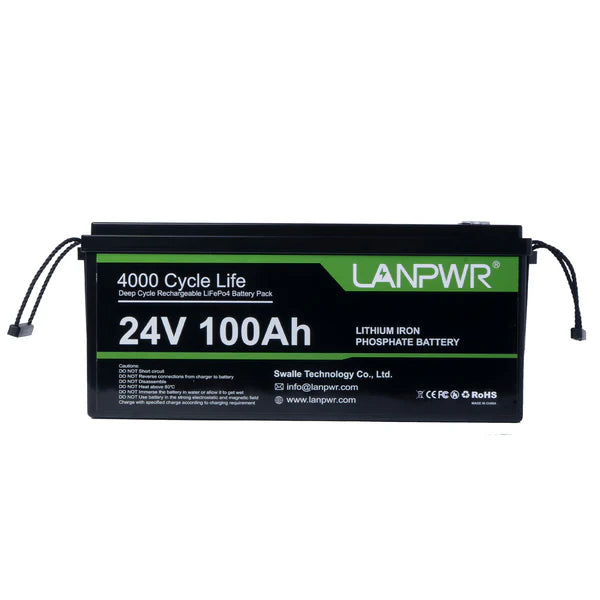Lithium iron phosphate (LiFePO4) batteries are increasingly popular in various applications due to their safety, efficiency, and longevity. They are widely used in electric vehicles, renewable energy storage systems, and portable electronics. This article explores the principles behind LiFePO4 batteries, explaining how they work, their benefits, and their applications.
What is a LiFePO4 Battery?
The lithium iron phosphate (LiFePO4 battery) or LFP battery(lithium ferrophosphate) is a type of rechargeable lithium-ion battery, which uses LiFePO4 as a cathode material. LFP batteries- Lithium Ferro Phosphate is the alternate name for the lithium iron phosphate (LiFePO4) class method. Liquid cooling and a bipolar array would also help to keep the lithium-ion phosphate pack at an even temperature, guarding against pack degradation that can harm cell conditions in other battery chemistries.
Key Parts of LiFePO4 Battery
- Cathode
The cathode is the positive electrode in a LiFePO4 battery. It is made from lithium iron phosphate (LiFePO4), which provides the necessary ions for the battery’s operation. This material is known for its stability and safety.
- Anode
The anode is the negative electrode, typically made from carbon in the form of graphite. The anode stores lithium ions during the battery’s charging phase.
- Electrolyte
Lithium salt in an organic solvent is used as the electrolyte These help to deliver the lithium ions from the cathode to the anode and recharge and discharge batteries.
- Separator
One of these is a separator, which acts similar to an energy harvesting device and might patch up the space that exists between the anode and cathode. It will not allow the electrode to directly contact another, but it does allow lithium ions to pass.
Working Principle of LiFePO4 Batteries
The working principle of a LiFePO4 battery involves the movement of lithium ions between the cathode and anode through the electrolyte. This movement is what generates electrical energy.
- Charging Process
During charging, lithium ions move from the cathode (LiFePO4) to the anode (graphite) through the electrolyte. Electrons flow through the external circuit from the positive to the negative terminal, balancing the charge. The chemical reaction at the cathode during charging can be represented as:
LiFePO4→FePO4+Li++e−\text{LiFePO}_4 \rightarrow \text{FePO}_4 + \text{Li}^+ + \text{e}^-LiFePO4→FePO4+Li++e−
At the anode, the reaction is:
Li++e−+C→LiC6\text{Li}^+ + \text{e}^- + \text{C} \rightarrow \text{LiC}_6Li++e−+C→LiC6
- Discharging Process
During discharging, the process reverses. Lithium ions move back from the anode to the cathode through the electrolyte, while electrons flow through the external circuit from the negative to the positive terminal. The chemical reaction at the anode during discharging is:
LiC6→Li++e−+C\text{LiC}_6 \rightarrow \text{Li}^+ + \text{e}^- + \text{C}LiC6→Li++e−+C
At the cathode, the reaction is:
FePO4+Li++e−→LiFePO4\text{FePO}_4 + \text{Li}^+ + \text{e}^- \rightarrow \text{LiFePO}_4FePO4+Li++e−→LiFePO4
This flow of ions and electrons generates electrical energy that can be used to power devices.
Advantages of LiFePO4 Batteries.
- Safety
There are chemical stability and thermal stability of LiFePO4 batteries as well.
Decreased Risk of Fire, and Explosion: With less risk of thermal runaway and overheating, they are less likely to catch fire or explode. They are therefore far safer than the anodes in most of today's lithium-ion batteries, which are constructed from lithium cobalt oxide (LiCoO2).
- Longevity
Below are eight trends that will shape enterprise IT this coming year that businesses everywhere need to start preparing for now. In turn, this results in more charge/discharge cycles during their lifetime -- around 2,000 to 3,000, before they experience a noticeable capacity decrease. Technically if this life is longer, it should be cheaper in the long run.
- Fast Charging
LiFePO4 batteries should fast chargers, and often also recover faster than other battery technologies. They feature higher charge and discharge currents to be able to recharge quicker! This is even more so if your application relates to high-throughput electric vehicle fast charging.
- Environmental Impact
That's in comparison to spinning the cathode material a mince lithium travels through in the cell - a greener process than most of the alternatives (cobalt, we're looking at you). A Safe Option: Unapparent to the environment but not as harmful as chemicals.
- Consistent Power Delivery
Flat-voltage-output batteries are employed to ensure that the voltage does not sag too heavily, which encourages more predictable power delivery. It is really impressive how stable the devices are being, even a full battery-drain cycle.
LiFePO4 Battery Uses
These properties make LiFePO4 battery an attractive type in various sectors, and applications, such as;
- Electric Vehicles (EVs)
For a battery, they have good safety and excellent cycle life, and as such are oftentimes used in electric cars. Automotive applications will require the same power and durability, as seen in use cases from Hitachi Automotive.
- Renewable Energy Storage
TiO2 nanotube form has been found in the growing use of LiFePO4-batteries, energy storage systems solar, wind, etc. This makes them ideal for the storage of power produced by renewable sources as they can be charged or discharged quickly and have a longer lifetime than most other batteries.
- Portable Electronics
These are the SMTs we find in a lot of modern-day portable electronic devices ( laptops, smartphones, or tablets). These applications are good candidates for supercapacitors because of their high power with constant power delivery profile and long cycle life.
- Backup Power Systems
These are an emerging type of rechargeable lithium battery for high volume and longevity applications to name a few solar-powered systems, 12v Lifepo4 battery for RV starting power, electric vehicles (EV), HEVs cars, digital tool packs as well as some other automotive etc. When the input power supply fails, the device supplies power and there is no ideal state. Those batteries have been running for weeks non-stop (this is why they still work and are safe).
- Recreational watercraft and ATV
The LiFePO4 batteries with this robust constructed mechanism help the battery stay last longer and one needs to apply them for marine or RV-type applications which is called longevity. Great for the weather and strong yous, these guys will get you going.
Challenges and Considerations
The kind of batteries that I work with, including the pros and cons as well as what to watch out for.
- Energy Density
Similar to NMC, Lithium Iron Phosphate (LiFePO4) has lower energy density This means less energy is stored in a given volume - which can be problematic, as such applications are normally size-restricted.
- Cost
Yes, LiFePO4s cost several times more than some other chemistries upfront but in the long run, they'll be far cheaper to operate because of their longer life and extremely low maintenance costs.
- Temperature Sensitivity
On the other hand, some information says that LiFePO4 batteries are very safe for a high-temperature application (above 35 degrees) but they can not be used at low temperatures. And something you should keep in mind while using it in cold places with these batteries.
- Weight
Lithium polymer had energy but less than LiFePO4. This is another thing to keep in mind when thinking about apps that have weight limits.
Future Developments
On the other hand, there also are research and development studies to improve this and improve LiFePO4 battery performance. The key thing is, especially with the batteries -- the most important thing being energy density increases, cost reductions, and certainly efficiencies that come from new battery technology in materials science.
- Improved Energy Density
The research is aimed at improving the rate and energy capacity of a new LiFePO4 cell without sacrificing its safety or longevity. It would also raise its energy density, which is currently well behind the most energy-dense lithium-ion batteries.
- Cost Reduction
As LiFePO4 batteries have relatively high production costs, many people are using this cost. This could mean anything from manufacturing, to what material is used, and how that process can be done in a more cost-efficient manner.
- Better Cold Weather Behaviour
Such changes as well as others to the liquid coloring and electrolyte formulations are part of efforts to increase the sluggish cold-weather performance of LFP batteries and make them applicable in a wider range of climates.
- Recycling and Sustainability
Suggest helping us develop recycling technology for recycling LiFePO4 batteries that will refund savings and a friendly environment the recycling involves procedure technology that obtains useful metals.
Summary,
LiFePO4 Power LiFePO4 power strikes a nice balance accommodating to such a large space. And if it is a SiC-based supercapacitor next to the stability, faster charging, and these also eco-friendly they will become one of the future energy storage tool kits.
We have to understand what the science behind LiFePO4 batteries means, so we can learn the advantages and drawbacks of them, and that our systems support them. This, however, implements high-performance secondary cell technology comparable to those from above battery performance back across use cases of different segments in multiple sectors from electric vehicles to grid-level storage of renewable energy. Wrapping your hands around LiFePO4 is getting fast into a green high-energy future, an easy and more able lane.














Leave a comment
This site is protected by hCaptcha and the hCaptcha Privacy Policy and Terms of Service apply.